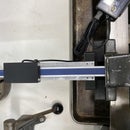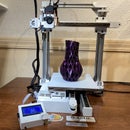Introduction: Taking Steady Lapse Video of Your 3D Prints
I'm a huge fan of OctoPrint. It allows me to monitor and control my 3D printer(s) from a web browser and when I'm away from my office, I get to monitor them via the Octoclient on my iPad or iPhone.
Besides control, one of the major benefits of OctoPrint is the Web cam feed and ability and to take time lapse photography of 3D prints.
The downside to this feature (as it currently stands) is the random placement of the Hot-end over the print. Each layer change a picture is taken and automatically assembled into a video. The only problem is the random position of the extruder at each layer change.
Following video is my C3Dt c printer at work (you can build it yourself with the instructions here)
One of the commenters "complained about the blurriness of the video. The Hot-end Nozzle zipping back and forth basically dominates the video.
This is where the plugin OctoLapse comes into play. It was designed specifically for placing the Hot-end at a designated position each time a picture is taken.
Here's a video I made yesterday with both OctoPrint timelapse and the OctoLapse plugin by FormerLurker.
The OctoLapse plugin allows you to either park the printer head somewhere away from the print and takes a picture with it out of side OR it allows to get creative with some other lapse mode (like hover of orbit). The following video is done using the "animated -printing" mode
Step 1: Equipment/software Needed
In my setup I run OctoPrint on a Raspberry Pi and I have tried several web cams before landing on the actual Raspberry Pi Camera Module V2. I worked with a cheap Logitec camera that had low resolution but worked, I tried a high resolution (1080p) Microsoft studio Web cam that DID NOT work.
current setup:
Raspberry Pi 3 B+ Amazon $48.99 https://amzn.to/2AhDnTg
32GB memory card Amazon $11.32 https://amzn.to/2OoAEui
Raspberry Pi Camera Module V2 Amazon $25.58 https://amzn.to/2AdPaC3
Custom rotatable camera case: Ebay $14.99 (plus shipping) https://www.ebay.com/itm/263834794011 (you can build this yourself here)
Adafruit Flex Cable for Raspberry Pi Camera - 2 meters: Amazon $9.55 https://amzn.to/2LwKlJ6
Software:
OctoPrint: https://octoprint.org/
OctoLapse instructions: https://github.com/FormerLurker/Octolapse/wiki
Step 2: Installing OctoLapse
For this instructable it's assumed you already have octoPrint up and running for your printer(s). If not check out one of the instructables on setting up Octoprint for your Printer (here's one)
The nice thing about OctoPrint is that it's openSource and many people are creating plugins for the server that make it easier to use and/or add features. OctoLapse is one of these plug-ins.
The easiest way to install a plugin in Octoprint is to click on the tools icon in the top menu bar which will popup the OctoPrint Settins page.
On it, click on the Plugin Manager item which presents you with a tab with all your current plugins.
On it, click on the "get More" button.
You can search for Octolapse in the search field and it should show you the plugin. If it's not been installed before it should show the Install button next to it (on my screen it shows reinstall).
You'll be prompted and you will need to restart octoprint after install.
After restart clean your browser's cache. CRTL-F5 might work but check the instructions for your browser.
Step 3: Setting Up OctoLapse
I'm not going into each step of setting up Octolapse as the OctoLapse Wiki does that perfectly
https://github.com/FormerLurker/Octolapse/wiki
I do want to put out there that my printer was not in the list of tested printers. This is not a problem. Select one of the existing printers in the list and edit its setting to match your printer/slicer settings. Make sure the retraction and speeds are the same as used in your slicer application.
Step 4: Running OctoLapse
All you have to do is turn OctoLapse on (on the Octolapse tab, top right).
You can run it simultaneous with OctoPrint TimeLapse (if you want to) or turn OctoPrint TimeLapse off.
The final rendered movie ends up on the TimeLapse page and you can download it from there.
If you like what you see in OctoLapse, don't forget to support the creator at https://www.patreon.com/FormerLurker
If you like this or my other instructables please consider doing the same for me at https://www.patreon.com/Core3d_tech
Good luck Printing!!











